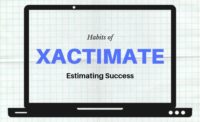The 10 Commandments of Xactimate Estimating Success

The insurance claims estimating world can feel like a wandering in the desert for restoration professionals. The frustration with the guidelines of program work and having to be reviewed by third party administrators (TPAs) can bring mitigation and construction estimators to a point where they feel lost and leaderless. Anyone who manages projects within the insurance claims industry must familiarize themselves with reading and writing Xactimate estimates. For those just beginning their journey in estimating insurance claims, you will find our Three R’s of Mastering Xactimate for Beginners to be a helpful baseline for success. The cloud of mystery that surrounds the stone tablets of this industry standard may scare and confuse many, but with the help of these ten commandments for Xactimate mastery you may find that you can achieve success.
Estimating with Xactimate Commandment 1
Thou shalt sketch accurately. Regardless of the tools that you use, make sure that you get your sketch right. An accurate sketch is the key to creating a solid Xactimate estimate. Sketching from the site is one of the best ways to ensure you get odd corners and turns in a unique layout accurate as well as capture all of your line items. Second best is utilizing sketching programs or a good graph notebook. If you are new to sketching for construction estimates, property restoration or Xactimate, check out this video on the foundations of a good diagram.
Estimating with Xactimate Commandment 2
Thou cannot take too many photos. For those who started in the industry when we had to print photos or save them on 3.5 in floppy disks, there may be some hesitation to take too many photos. With modern digital technology this is no longer true. The more photos that you take the better. Always take photos of the front of loss, source, shots from all corners of affected rooms, affected materials, equipment and any unique components of the claim. Learn what carriers and adjusters are looking for as it is a terrible waste of time to have to run back out to a project just for one shot to justify a key line item.
Estimating with Xactimate Commandment 3
Thou shalt label they photos descriptively. Common descriptions should include the room name and what is being represented with the photograph such as “Kitchen floor damage” or “Living room ceiling affected”. Carriers are often requesting that photos be uploaded in relationship to the sequence of rooms in the sketch, this can be easily done by dragging photos into the rooms when uploading into Xactimate.
Estimating with Xactimate Commandment 4
Thou shalt utilize thy F9 notes. F9 notes can be used for formatting but breaking up large sections of line items into categories that make the estimate easier to read for reviewers, adjusters and your production teams. F9 notes can be used to describe how a line item is being utilized, for example DRY LF may have an F9 note of “Repair flood cuts for common wall to bathroom” especially if there is another drywall line item in the room that may be for the ceiling or separate section of wall. If you ever utilized a labor (LAB) line item you must understand that it is going to be questioned and should have an ample F9 note, photographic support for the scope being requested and best to have the designation as “approved by adjuster,” assuming that you have already discussed it with them. Communication is key, utilize this simple function.
Estimating with Xactimate Commandment 5
Thou shalt document your initial findings. Whether it’s a 12 hour update for a mitigation claim or a loss narrative for a repairs claim, you need to communicate the conditions you have found once you have completed your inspection. For mitigation projects you are communicating the site conditions, source and drying plan. For repairs projects you are confirming the site conditions and outlining the scope of work that you are estimating for. Samples of what should be covered in the twelve hour update as well as the loss narrative include:
12 hour update for mitigation
- Was extraction performed
- Source of loss (communicate category and class of water)
- Rooms affected (it helps to provide a general scope of mitigation)
- Initial moisture readings
- Equipment set (this is a good time to request approval for any specialty equipment)
- Estimated duration of drying (you may need to request more than 3 days of drying time, document why.
- Any lead, asbestos or other conditions that may delay mitigation
Loss narrative for repairs
- Source of loss
- Condition of home
- General scope (it helps to provide a general breakdown by room/area)
- Any specialty conditions
Estimating with Xactimate Commandment 6
Thou shalt update thy adjuster in real time and document consistently. One of the keys to success for any organization or project management system is communication. A key principle for communication in the insurance claim industry is no surprises. Utilize email, text, phone calls and third-party programs such as Xactanalysis to communicate consistently and clearly with all parties. While some adjusters may have you wait until the end of a claim to compose all of your supplements and changes, you want to make sure that you aren’t waiting until then to communicate and acquire some form of written approval. You want to build relationships with adjusters and claims administrators and communication is a means to making their job easier by not surprising them with alterations to the plans previously agreed to.
Estimating with Xactimate Commandment 7
Thou shalt learn thy carriers guidelines. While it is impossible to remember all of them unless you are able to specialize with specific carriers, it is important to know the key rejection line items. Pay attention to what you are getting rejected for. Try to not repeat the same mistakes with the same carriers. Every carrier has their general rules as well as their idiosyncrasies. For example one carrier will want contents as CON LAB and another will want to see it as CON ROOM. It should only take one rejection for you to understand and remember which carrier prefers the line item one way or the other.
Estimating with Xactimate Commandment 8
Thou shalt know thy line items – apply thyself to understand the process of line item approvals. If you do not want to be constantly frustrated by rejections you must quickly learn which line items will get rejected by reviewers or will require adjuster approval. When working with third party administrators (TPAs) you will have to work through layers of review and approvals based upon insurance carrier guidelines. If you have a scope of work that falls outside of the norm you will need to get in communication with the adjuster to discuss how they would like that scope of work broken down. A scope and line items that may not pass through the normal review process can be overridden if there is ample explanation through F9 notes, photos and the designation that this has been “approved by adjuster”.
- (This is not a commandment but it certainly is helpful) Thou shalt know thy line items – memorization. Within 6 months to a year of writing Xactimate estimates you should be able to call out the line items and write you most frequent estimate scopes without the search function. The last thing you want to do as an estimator is to leave money on the table when it is warranted and necessary to the servicing of the claim. For this reason many experienced restoration professionals utilize macros for their scopes of work to ensure that they don’t forget key items as well as those secondary items that take an estimate into a realistic plain for making money. Macros can be time consuming to set up and edit so another option is to save and label estimates with key scopes that have been approved so that you can cut and paste from them in the future.
Estimating with Xactimate Commandment 9
Thou shalt know thy line items – thou shalt understand thy line item descriptions. When you start writing estimates in Xactimate you need to take some time to familiarize yourself with what is and isn’t in a line item. As a general rule, most carriers do not want you to utilize labor (LAB) line items as in theory everything that needs to be done should be covered in a line item scope of work. For those items that are out of the ordinary you need to ensure that there isn’t an Xactimate line item that covers the work you are requesting labor for. Also, ensure that you aren’t duplicating a scope of work that is already covered in the line item while also ensuring that you aren’t cutting yourself short by missing items that are omitted from the line item description.
Estimating with Xactimate Commandment 10
Thou shalt learn to master the trifecta of service, expedience and accuracy. Restoration creates the challenge of getting in and getting out expediently while providing a quality service and communicating with multiple parties. When the scope of work falls outside of the timeline requirements be sure to communicate and update frequently. Restoration professionals have to be skilled in the construction and mitigation trades, must be able to provide a high level of customer service which is grounded in communication and are required to be technologically proficient to utilize the industry tools.
Insurance claims estimating mastery starts with knowing the guidelines of Xactimate
When Moses came down from Mount Sinai with the two stone tablets, there were questions and fear, but there were also some clear directives. Xactimate and program guidelines generate similar emotions but one cannot argue that there are keys to success when working with the estimating software. You can argue all you want about who gave the directives, who is interpreting the guidelines and whether the system is fair, but you also had better apply your energy to learning Xatimate’s keys to success. If you are just starting out in your estimating journey, you may find our Three R’s of Mastering Xactimate for Beginners to be helpful. Insurance claims are subject to some level of interpretation so mastering the tools of the trade is essential to achieving success with the process.
Looking for a reprint of this article?
From high-res PDFs to custom plaques, order your copy today!








